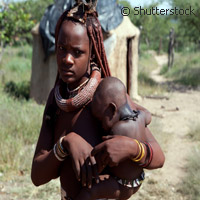Pick up the pace to make HIV/AIDS services accessible to all, says new status report
Encouraging first successes on the long road to universal access to HIV/AIDS (human immunodeficiency virus/acquired immune deficiency syndrome) services have emerged, says a new report released on 28 September. However, the report also calls on the international community to intensify its efforts to meet this goal. It is the fourth annual report tracking progress in achieving the 2010 target of providing universal access to HIV prevention, treatment and care, published jointly by the World Health Organization (WHO), the United Nations Children's Fund (UNICEF) and the Joint United Nations Programme on HIV/AIDS (UNAIDS). According to the report, findings from 144 low- and middle-income countries have revealed a range of remarkable successes in 2009. As many as eight countries, including Cambodia, Cuba and Rwanda, are reported to have achieved universal access to antiretroviral treatment (ART) for adults. In 15 countries, e.g. Botswana, Guyana and South Africa, the services and medicines required to prevent mother-to-child HIV transmission are now available to more than 80% of HIV-positive women in need. A total of 14 countries, such as Brazil, Namibia and Ukraine, were able to provide HIV treatment to more than 80% of HIV-positive children. The world's worst-affected region, eastern and southern Africa, has managed to boost treatment coverage from 32% to 41% within a single year. 'Countries in all parts of the world are demonstrating that HIV/AIDS universal access is achievable,' commented Dr Hiroki Nakatani, WHO's Assistant Director-General for HIV/AIDS, Tuberculosis, Malaria and Neglected Tropical Diseases. 'But globally, it remains an unfulfilled commitment. And we must join forces to make it a worldwide reality in the coming years.' Dr Paul De Lay, the Deputy Executive Director of the Programme at UNAIDS, agrees, saying: 'We're on the right track, we've shown what works and now we need to do more of it. But we're USD 10 billion [around EUR 7.3 billion] short. At the Global Fund replenishment conference in New York next week countries have a chance to put this right - to make a smart investment and secure the future of the AIDS response.' Indeed, the report highlights major challenges. These include limited financial and human resources as well as health system bottlenecks notably with regard to procurement and supply management for HIV drugs and diagnostics. Moreover, prevention efforts to reach populations at particular risk, such as sex workers and drug users, are generally described as 'limited'. Other concerns centre on the safety of blood and blood products, where quality-assured screening was, for example, performed on average for only 48% of the blood donated in low-income countries. And, worryingly, surveys in 10 countries revealed that more than 60% of HIV-positive residents were unaware of the HIV status, with many patients starting their treatments too late. 'The report findings indicate challenges but also clear opportunities for optimising investments and increasing efficiency. By starting treatment earlier and improving adherence within the first year, we can save many more lives,' said Dr Gottfried Hirnschall, WHO's Director for HIV/AIDS. 'We also need to not only further increase access to key HIV/AIDS interventions but also to pay attention to ensure higher quality of these life-saving services.' In total, the number of people receiving HIV treatment has increased by 1.2 million compared to December 2008, which represents the biggest annual increase to date. Prevention of mother-to-child transmission (PMTCT) remains a particular challenge. Globally, PMTCT services were provided to 53% of the pregnant women who needed them in 2009; this represents a significant improvement over previous years. However, this still leaves many children at risk, and only 15% of the babies born to HIV-positive women benefit from appropriate infant diagnostics. The report also stresses that, at 28% versus 36%, the global treatment coverage for HIV-positive children remains lower than the ART coverage rate for adults. 'Every day, more than 1,000 infants acquire HIV during pregnancy, delivery and breastfeeding. We know how to prevent this,' says Jimmy Kolker, Chief of HIV and AIDS of UNICEF. 'While many countries are now showing significant progress, intensified efforts are urgently needed to reach all mothers and children with the most effective treatment and PMTCT interventions for their own health and for the sake of their communities.' The report calls on the international community to pick up the pace in the fight against HIV/AIDS. It highlights the need to renew political and funding commitments, strengthen public health systems, and eliminate the barriers that stand in the way of effective HIV prevention, particularly for groups at higher risk. The linkages between HIV/AIDS services and related services, such as those combating tuberculosis or promoting maternal and child health, sexual health and harm reduction for drug users, must also be improved. This urgent call to action ties in with the key strategies outlined for the forthcoming Global Health Sector Strategy for HIV/AIDS for the period 2011-2015. This strategy is currently being formulated by the WHO for consideration by the World Health Assembly in 2011.
Countries
Brazil, Botswana, Cuba, Guyana, Cambodia, Namibia, Rwanda, Ukraine, South Africa



